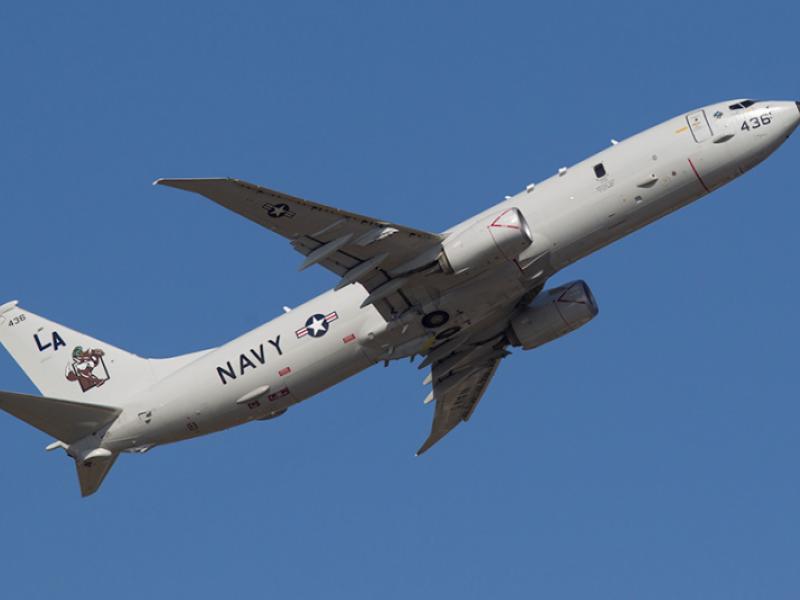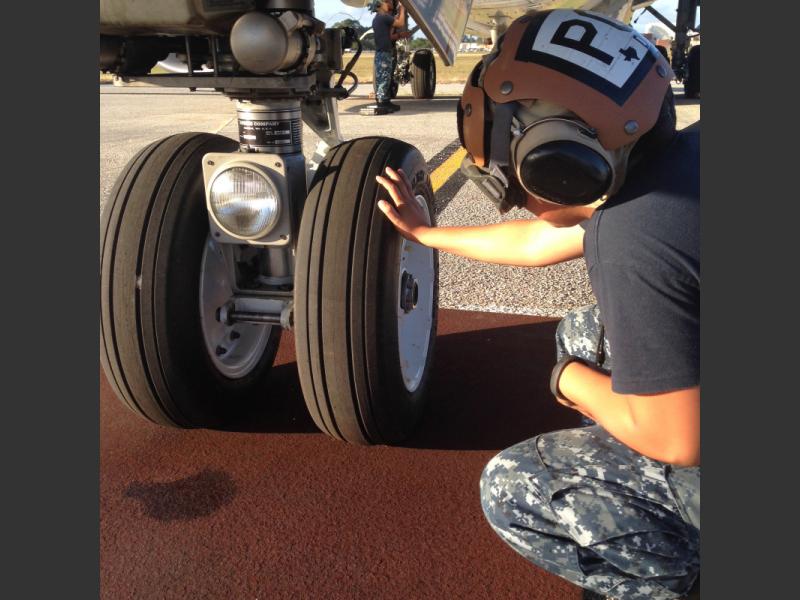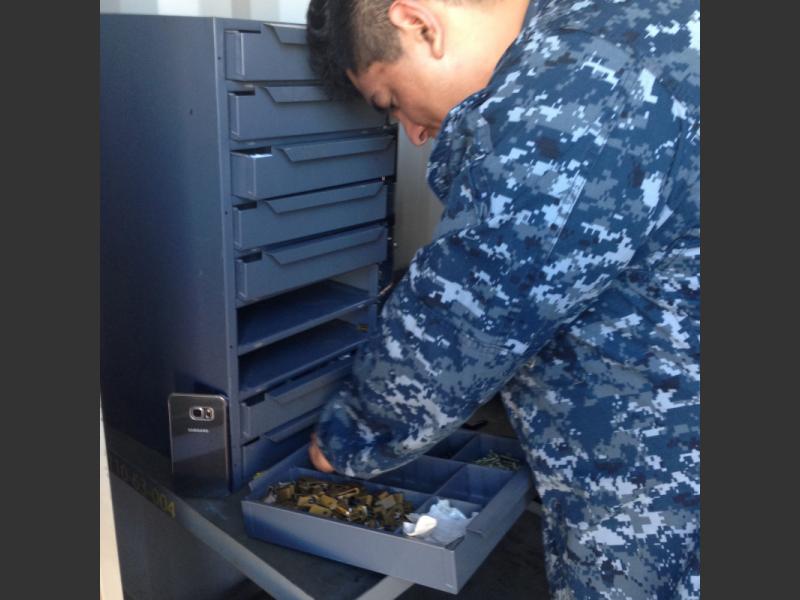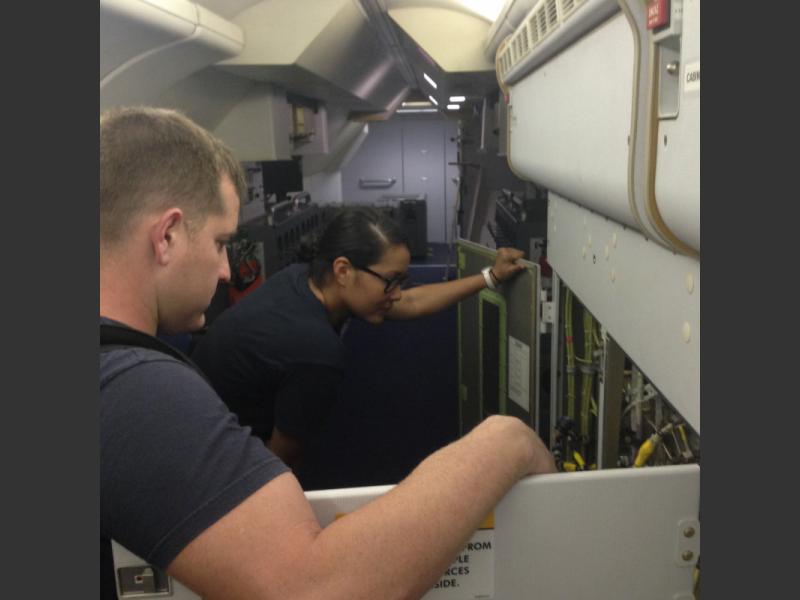2016-06-13 By Robbin Laird and Ed Timperlake
The P-8 is a new plane unlike the P-3.
That brings clear advantages compared to the P-3 at the end of its service life.
In one of our discussions at Jax Navy, one of P-3 operators made the point that they were spending more time getting the P-3 out the door than focusing on the mission.
With a new aircraft, you start with a new slate.
But a rule of thumb is it takes 10 years until one really knows what the realistic and best maintenance rhythm is for an air combat platform.
The P-8 is a military version of the 737 but there is no simple transfer of commercial domain knowledge to operating the P-8. The P-8 is a combat asset and is operated very differently from a commercial airliner, and with its low flight envelope over the water up to higher altitudes faces a significant corrosion challenge as well as stress on its engines, of the sort no commercial airliner would have to deal with.
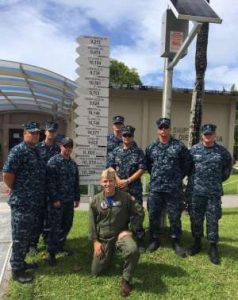
It is also a combat asset which means that the military needs to ensure it has parts and is not simply relying on a commercial just in time delivery system.
But there is a clear opportunity as allies buy the jet – India, Australia and the United Kingdom are already doing so – that a global approach to sustainment might well emerge which would enhance the operational temp of each service using the aircraft.
We had a chance to discuss some of these issues with three mechanics from VP-16, with VP-16 having the longest operational experience with the aircraft.
We discussed the experience to date and the way ahead with Master Chief Ragin who has been a VP mechanic for most of his 23 years in the US Navy and with three years with the P-8, with Senior Chief Tucker, an aviation electronics technician with 17 ½ years of experience and he came to VP-16 in November 2013 and supported the first deployment and, finally, and Lt. Junior Grad or LTG Speed with 20 years of experience and she came to the P-8 at the time of its first deployment as well.
We asked about any advantages on deployment to the aircraft being a 737.
“If you can access a trusted buyer it is possible to get commercial pars, but our own supply system only utilizes their process to get secure parts. If we could access the commercial sector when deployed it would save us time waiting for parts and enhance aircraft availability.”
Currently, this is difficult and “when we deploy around the world we currently take our own support equipment, our own tires and our own parts.”
Clearly, working with trusted vendors can shorten the supply chain problem when deployed.
“We had an issue on deployment where a lightening strike damage one of our aircraft.
A team from Boeing came out to survey the damage. We needed to replace a part and did not have that part in our inventory in Navy Supply.
The Navy went out into the commercial sector and bought part and it came in quickly when ordered and it had Made in Australia stamped on it.”
These experienced professionals touched on a significant issue. It has been said some of the best Generals in the American way of war are General Motors, General Electric and General Delivery among others.
The Navy Supply Corps is one of the most unheralded military specialties making it possible for the global combat operations of the US Navy/Marine team.
A specific point made about the evolving P-8 supply chain was amplified by a retired Navy Supply Officer James “Jim” Druso who supported both subs and aviation units and when he retired became the Security Officer for the Iraq Ministry of Transportation. He has seen both the Navy way and commercial supply operations into a nation at war.
Commander Druso touches on several points in the evolving partnership between Maintenance and Supply.
He understands the dynamic trade off between COTS (commercial off the shelf” and Mil_Spec (those necessary parts that must be designed to military specifications.) He has also had the experience of being part of a supply chain into a combat situation and all the insurance issues with commercial carriers.
Needless to say Navy supply is evolving parts in partnership with a global fleet of P-8s:
“As the P-8 is a militarized Boeing 737-800, a significant number if its parts are stocked worldwide in support of the commercial fleet of 737s.
This will allow the inventory managers to focus on building demand history and inventory for the Navy-unique items.
It will be all the more challenging as it will be done in a down budget environment.”
Clearly, the P-3 is different from the P-8. With regard to engines, the maintainers noted that with a P-3 engine to do a repair you have to strip it down to get it repaired. You have to pull it apart, do all kinds of checks, before you can get it back into service.
With the P-8 you drop the whole engine, and put it back it back up in no time and you are back in engine.”
The P-3 is an analog aircraft; the P-8 is a digital one and much of the maintenance differences flow from that.
“The plane does a number of self diagnostics and we use that information to aid is in the maintenance cycle.”
Clearly, with the deployment cycle a work in progress, correctly determining the stockpiling and flow of parts is a work in progress.
“During our deployment to Japan, we had most of our supplies shipped from the States and had to wait for parts to shipped to us because we did not have them in stock. All parts ordering is done manually.”
The maintainers argued that from the first to the second deployment there were major improvements in terms of delivering supplies to repair the deployed aircraft.
And the mix of specialties to maintain the aircraft is a work in progress.
For example, the expectation was that the engines would need less repair than they are actually experiencing them. The maintenance department was sized with the expectation that engines would need less repair than they do; the Navy is having to adjust to the operational experience of the aircraft, and the engines are a case in point.
They pointed as well the need to deal with corrosion control from the outset, as the way the aircraft is operated will lead to corrosion in a way which would never be seen by a commercial variant.
They pointed out that with the learning curve, the Navy was learning which parts were the higher failure items and trying to stockpile those in Kadena to support the operations of the aircraft from Japan.
But for now there are few global stockpiles given the program is in its early stages.
One part of the maintenance process is doing the software upgrades. According to the mechanics, Boeing does these upgrades in the hangar. “The technicians come on site and do the software upgrades. Boeing tests everything. They just give us certificate of completions when they’re done.”
Editor’s Note: In a 2011 visit to San Diego, senior Navy personnel discussed both the coming of the P-8 and the supply challenges for a new aircraft such as the P-8.
As Captain Kelly then the Force Material Officer at Commander Naval Air Forces put the challenge:
We’re changing out 100-percent of our platforms. At the same time, we’re at one of our highest operational tempos. For instance, we’re getting P8s for P3s, we’re getting Growlers for Prowlers, and we’re getting Super Hornets for Legacy jets. We’re getting E2Ds for E2Cs and we’ll get F-35s thrown into the mix.
So, everything’s changing out, so from our perspective, we have to work with NAVAIR to make sure that the maintenance plans and the constructs for logistics and sustainment are well grounded for everything that’s coming, while we’re managing everything that is already here and deployed.
And then, we have to manage to do the swap outs of airplanes and the retraining of personnel in a fashion so that we don’t impact the operational schedule.
SLD: And the problem is that when one swap outs, historically, whether it be a commercial fleet or military fleet, it is more expensive in the transition. You’ve got to manage the old as you bring in the new.
Captain Kelly: And that’s why we’re pressurized to do it kind of as quickly as we can, because we don’t want to eat cost in two spots at once.
https://sldinfo.com/the-challenge-of-maintaining-a-global-fleet/
https://sldinfo.com/transitioning-from-the-p3-to-the-p8/
Now the mechanics at Jax Navy are living the challenge and working the solutions.
Two stories have appeared in the Jax Air News which have highlighted the role of maintainers.
The first was published November 18, 2015 and was written by the VP-5 PAO and focused on the performance of the maintainers in the “Mad Foxes” squadron.
The “Mad Foxes” of Patrol Squadron (VP) 5 received high marks on their Maintenance Program Assessment (MPA) conducted Nov. 2-6 at Cecil Airport.
The hard work of the maintenance department was evident throughout the entire MPA inspection – a graded maintenance department analysis performed by inspectors from Commander, Patrol and Reconnaissance Wing 11.
The purpose of the program is to highlight discrepancies in standard maintenance operating procedures, prior to their Aviation Maintenance Inspection (AMI).
The VP-5 Maintenance Department completed seven drills and 64 practical applications during the assessment – all while juggling a heavy flight schedule with multiple flights per day. Despite these additional hurdles, the department finished with an overall satisfaction rating of 100 percent on all drills and practicals.
VP-5 Commanding Officer Cmdr. Al D’Jock was absolutely thrilled with his maintainers’ performance.
“There was never a doubt in my mind that our maintenance team would knock this inspection out of the park. I couldn’t be more impressed with the hard work that maintainers put into the preparation and execution of this challenging inspection. This is a direct reflection of the professionalism of this department and I can’t wait to see how well they perform during our upcoming AMI,” said D’Jock.
The Mad Foxes Maintenance Team will begin their AMI Jan.18.
VP-5 is currently halfway through their inter-deployment readiness cycle at NAS Jacksonville and Cecil Airport, and will soon start the Operational Readiness Evaluation (ORE) portion of their home cycle.
The Mad Foxes will continue training to ready themselves for their upcoming historic worldwide deployment next year.
And the photo below shows maintainers during the worldwide deployment of the Poseidon which was the digital age version of the Great White Fleet.
In a second story, more recent, maintainers are seen working on the certification for “safe flight” of the final P-8 squadron at Jax Navy.
In a story written by the VP-26 PAO and published on May 18, 2016, the certification for “safe flight” was discussed.
The “Tridents” of Patrol Squadron (VP) 26 received their P-8A Safe for Flight (SFF) certification from Commander, Patrol and Reconnaissance Group (CPRG) May 4, after a series of inspections that took place the week of April 25.
“This is huge,” declared Lt. Cmdr. Michelle Higingbotham, the maintenance material control officer of VP-26. “Our fleet readiness cycle has commenced and now that we have been qualified safe for flight we can prepare for deployment.”
Higingbotham stated that the SFF qualification marks the end of the transition of VP-26 from a P-3C Orion squadron to a P-8A Poseidon squadron. Although the Tridents accepted their first P-8A two months ago, they have been operating under the supervision of fleet replacement squadron VP-30. This safe for flight inspection marks the date when VP-26 is certified to operate independently.
The inspection certified the Tridents’ ability to operate safely as a P-8A squadron, and according to VP-26 Commanding Officer Cmdr. Mark Burns, the squadron scored higher on their SFF inspection than any of the squadrons that previously have made the transition to the P-8A.
The Tridents’ transition to the P-8A began in October of 2015 and marks the end of an era for active duty operational P-3C squadrons on the east coast. With the exception of two reserve squadrons and VP-30, the long reigning P-3C has officially been replaced by the P-8A at NAS Jacksonville. With the east coast transition complete, the last P-3C squadrons in Hawaii and Whidbey Island, Wash. are poised to begin their transitions later this year.
Earlier this year on March 16, Lt. Jared Stolle of VP-26 piloted the completion of the squadron’s first acceptance check of a P-8A Poseidon, bureau number 168848, from VP-30. The acceptance involved two consecutive days of inspections beginning with an on-deck test of the engines called maintenance turns, followed by an in-flight check called a functional check flight or FCF. The FCF is a comprehensive six-hour evaluation of airworthiness. Each flight system is tested to ensure proper function. The squadron’s first FCF was successful and the squadron was now ready to begin training for its first P-8A deployment slated for early 2017.
This summer, VP-26 will be participating in BALTOPS 2016, a multinational exercise hosted by Commander U.S. Naval Forces Europe. They will also be participating in exercises in Keflavik, Iceland and Lossiemouth, Scotland.


